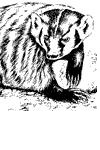 Badgers in Arizona - February 4, 2015 Jeff Schalau, Agent, Agriculture & Natural Resources University of Arizona Cooperative Extension, Yavapai County Most Yavapai County residents have probably never seen a badger in the wild, but they are here and there are probably many reasons that people donít see them. For one, they are primarily nocturnal. For another, they are not very tall and may be well hidden to the untrained eye. However, if you hike around the backcountry, especially with dogs, you (and the dogs) could be surprised by a badger. If you understand the badgerís biology and behavior, you might be more likely to see one (or not: depending on your preference). The badger (Taxidea taxus) is a stocky, medium-sized mammal with a broad head, a short, thick neck, short legs, and a short, bushy tail. Its front legs are stout and muscular with long front claws making it an excavating machine. Its fur is silver-gray with long guard hairs, a black patch on each cheek, black feet, and a characteristic white stripe extending from its nose over the top of its head. In Arizona, adult badgers usually weigh between 10 and 20 pounds and may be found anywhere in the state where a hole can be dug. Badgers are members of the weasel family and have the musky odor characteristic of this family. Their digging capability is used to pursue and capture ground-dwelling prey. Typical burrows dug in pursuit of prey are shallow and about 1 foot (30 cm) in diameter. A female badger will dig a deeper burrow (5 to 30 feet long [1.5 to 9 m]) with an enlarged chamber 2 to 3 feet (0.6 to 0.9 m) below the surface in which to give birth. Dens usually have a single, often elliptical entrance, typically marked by a mound of soil in the front. Badgers have a rather ferocious appearance, and when confronted, often make short charges at an intruder. They may hiss, growl, or snarl when fighting or cornered. Their quick movements, loose hide, muscular body, and tendency to retreat quickly into a den provide protection from most predators. Larger predators such as mountain lions, bears, and wolves will kill adult badgers. Coyotes and eagles can kill young badgers. Badgers remain in dens during daylight hours, but are often seen at dawn or dusk. Their eye shine at night is green. During winter they may remain inactive in their burrows for up to a month, although they are not true hibernators. Male badgers are solitary except during the mating season, and females are solitary except when mating or rearing young. National data reports densities of badgers are about 1 per square mile although they are likely much more widely dispersed in Arizona due to development and prey availability. Badgers are carnivorous mainly feeding on small rodents such as rock squirrels, gophers, prairie dogs, woodrats, kangaroo rats, deer mice, and voles. They may also prey on ground nesting birds, such as bank swallows and burrowing owls, snakes, lizards, amphibians, carrion, fish, hibernating skunks, insects, including bees and honeycomb, and some plant foods, such as corn and sunflower seeds. Unlike many carnivores that stalk their prey in open country, badgers catch most of their food by digging. They can tunnel after ground dwelling rodents with amazing speed. Badger burrows also provide shelter for other species and their digging activity increases water infiltration and has a positive influence on soil development. Badgers and coyotes are sometimes seen hunting at the same time in a seemingly cooperative manner. Badgers dig and cause small rodents to flee. Coyotes can readily run rodents down, but cannot effectively dig them out of burrows. Coyotes can take advantage of rodents attempting to escape from badgers. Badgers may not benefit as much as the coyotes, but each tolerates the otherís presence and they may even engage in play behavior. Maintaining open space provides habitat for badgers and the ecosystem services they provide are beneficial to other species. If any readers are concerned about badgers damaging their property or crops, please let me know. As usual, I have included additional resources below. Follow the Backyard Gardener on Twitter Ė use the link on the BYG website. If you have other gardening questions, call the Master Gardener help line in the Camp Verde office at 928-554-8999 Ext. 3 or e-mail us at verdevalleymg@gmail.com and be sure to include your name, address and phone number. Find past Backyard Gardener columns or provide feedback at the Backyard Gardener web site: http://cals.arizona.edu/yavapai/anr/hort/byg/. Additional Resources Badger Arizona Game and Fish Department www.azgfd.gov/h_f/game_badger.shtml Badgers Internet Center for Wildlife Damage Management icwdm.org/handbook/carnivor/badgers.asp Managing Badger Damage University of Wyoming Cooperative Extension Service www.wyomingextension.org/agpubs/pubs/B1004.pdf |